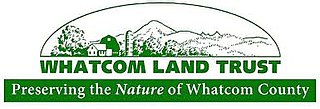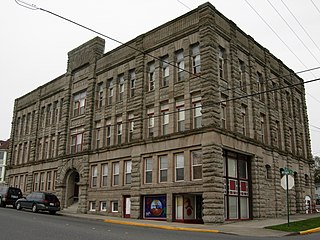
Bellingham is the county seat of Whatcom County in the U.S. state of Washington. It lies 21 miles (34 km) south of the U.S.–Canada border, between Vancouver, British Columbia, 52 miles (84 km) to the northwest and Seattle 90 miles (140 km) to the south.

Whatcom County is a county located in the northwestern corner of the U.S. state of Washington, bordered by the Lower Mainland of British Columbia to the north, Okanogan County to the east, Skagit County to the south, San Juan County across Rosario Strait to the southwest, and the Strait of Georgia to the west. Its county seat and largest population center is the coastal city of Bellingham. Whatcom County is coterminous with the Bellingham, WA Metropolitan Statistical Area. As of the 2020 census, the county's population was 226,847.

Fairhaven was a settlement in Washington state founded in 1883 by Dan Harris. In 1903, it became part of the city of Bellingham and remains a historic neighborhood.
The Sehome Hill Arboretum is a public park in the Sehome neighborhood of Bellingham, Washington. It comprises 175.5 acres (71.0 ha) of second growth forest on Sehome Hill, adjacent to the campus of Western Washington University. Though called an arboretum, the hilly expanse atop Sehome Hill is not consciously planted as an exhibit of tree species, but naturally wooded and rich in the plant species typical of the region. The arboretum is jointly managed by both the university and the city. Its care is overseen by the Sehome Hill Arboretum Board of Governors, composed of city employees, university employees, university students, and city residents. The park offers students and city dwellers over 5 miles (8 km) of public trails for walking and running and, in some areas, bicycling. Unique features of the park include an 80-foot (24 m) wooden observation tower atop Sehome Hill, with aerial views of Bellingham Bay to the south. There is also a large tunnel, hand cut into rock in 1923, originally used for car traffic in the early 1900s. Its tall, thin shape shows its creation for cars like Model T Fords of the day. Cars are no longer allowed in the tunnel and it is part of a trail along which hikers can walk.
Bellingham School District No. 501 is a public school district serving Bellingham, Washington. The district enrolls nearly 12,000 students across its schools and programs, and is the fourth-largest employer in Whatcom County. The strategic plan of Bellingham Public Schools is known as "The Bellingham Promise".

State Route 11 (SR 11) is a 21.28-mile (34.25 km) long state highway that serves Skagit and Whatcom counties in the U.S. state of Washington. SR 11, known as Chuckanut Drive, begins at an interchange with Interstate 5 (I-5) north of Burlington and continues northwest through several small towns and the Chuckanut Mountains to the Fairhaven district of Bellingham, where the highway turns east and ends again at I-5.

State Route 539 is a north–south state highway in the U.S. state of Washington. The highway travels through northwestern Whatcom County and connects Interstate 5 (I-5) in Bellingham with Lynden and the Canadian border near Langley, British Columbia.

Sehome High School (SHS) is a public high school in Bellingham, Washington. Sehome is one of four high schools operated by Bellingham Public Schools, and primarily serves students from southern Bellingham. 1,179 students were enrolled for the 2023–2024 school year. Sehome competes as the Sehome Mariners in the Washington Interscholastic Activities Association Northwest Conference (2A).

KUGS is a college radio station in Bellingham, Washington, United States, owned by Western Washington University (WWU). It is managed by WWU students and broadcasts from studios in the Viking Union on the WWU campus in Bellingham and a transmitter atop Sehome Hill.

Whatcom Falls Park is a 241-acre (0.98 km2) park in Bellingham, Washington, United States. The falls are on Whatcom Creek, which leads from Lake Whatcom to Bellingham Bay. The park has four sets of waterfalls and several miles of well maintained walking trails.
The Whatcom Transportation Authority (WTA) is the public transit authority of Whatcom County in northwestern Washington, based in the city of Bellingham. It provides bus service on 28 fixed routes, including four branded "GO Lines" with 15-minute frequencies on weekdays. In addition to bus service, the WTA offers paratransit service and a vanpool programs.
The Bellingham Waterfront consists of the land along Bellingham Bay in Whatcom County, Washington, United States. It is mostly in Bellingham, Washington and other surrounding neighborhoods and cities. Various Bellingham neighborhoods are along the waterfront including is shared with Fairhaven.

State Route 544 is a state highway in northern Whatcom County, Washington, United States. It runs east–west for 9 miles (14 km) near the Canadian border, connecting SR 539 near Lynden to Everson and a junction with SR 9 in Nooksack.
The history of Bellingham, Washington, as it is now known, begins with the settling of Whatcom County in the mid-to-late 19th century.

Galbraith Mountain is the common name for North Lookout Mountain, located between the communities of Sudden Valley and Bellingham, Washington. It has been rated the best mountain bike trail system in the state of Washington. Galbraith Mountain is located between Lake Padden and Lake Whatcom.

Whatcom Land Trust is a non-profit organization based out of Bellingham, Washington that works to preserve and protect wildlife habitat, scenic, agricultural and open space lands in Whatcom County. The mission of Whatcom Land Trust is to preserve land for future generations and to promote land stewardship.

The Fairhaven and Southern Railroad and its successor the Seattle and Montana Railroad were railroads in northwest part of the U.S. state of Washington, active in the late 19th and early 20th centuries. They ran roughly south from Blaine, Washington on the U.S.-Canada border. The Fairhaven and Southern operated 1888-1898 and ran to Sedro. It operated from December 1891 as part of the Seattle and Montana Railway, and was merged with that into its successor, the Seattle and Montana Railroad, both of which extended service south to Seattle. The Seattle and Montana operated until 1907 when it merged into the Great Northern Railway Company.

The Lottie Roth Block is an historic commercial building located near downtown Bellingham, Washington and is listed on the U.S. National Register of Historic Places. Built by quarry manager and Washington State Legislator Charles Roth and named after his wife, Lottie, the building is clad in the famous Chuckanut Sandstone from his Bellingham Bay Quarry that would be used in countless building projects across the region. Completed in 1891, it was one of the last large commissions of noted Northwest architect Elmer H. Fisher and his only project in Whatcom County. While initially built as an office/retail building in anticipation of the commercial expansion of the town of Whatcom, it was converted entirely to apartments by 1912 when commercial development moved in the opposite direction towards New Whatcom, which after 1903 became the new city of Bellingham's downtown. Still strictly serving as a residential building to the current day, the Lottie Roth Block was listed on the National Register of Historic Places on December 12, 1978.

John Joseph Donovan was a Washington State pioneer and the president of the state Chamber of Commerce, as well as one of the key founders of the City Council of Bellingham, Washington. During his life, Donovan actively participated in political, industrial, and commercial activity on city, county, and state levels. Several historic landmarks exist in Bellingham honoring J. J. Donovan, including his house, which was added to the National Historic Register, and a bronze statue installed in Fairhaven, Washington.

Old Main is a historic building on the Western Washington University campus in Bellingham, Washington. Constructed in 1896 to house the new Normal school and opened for classes in 1899, it is the oldest building on the campus. It currently serves as administrative and student services offices.


















